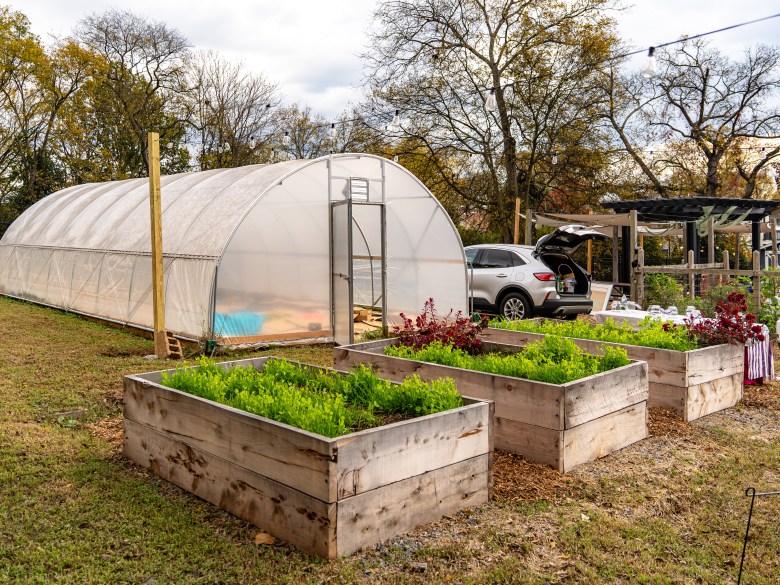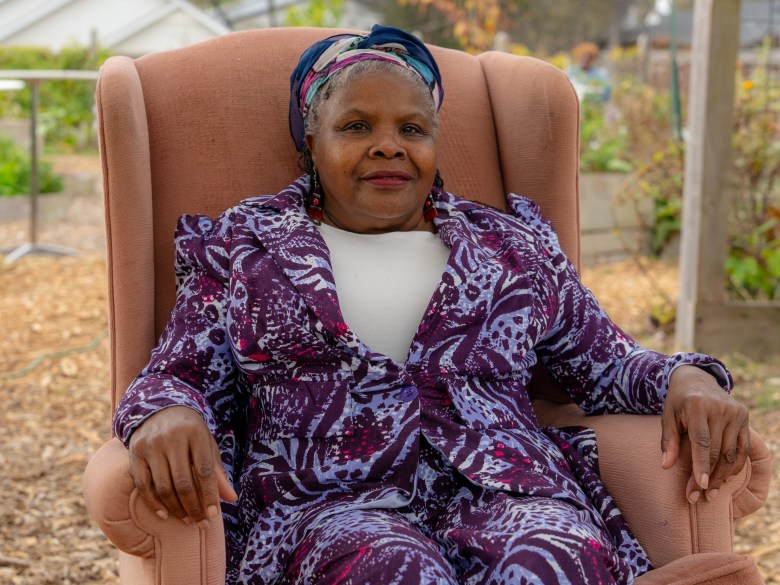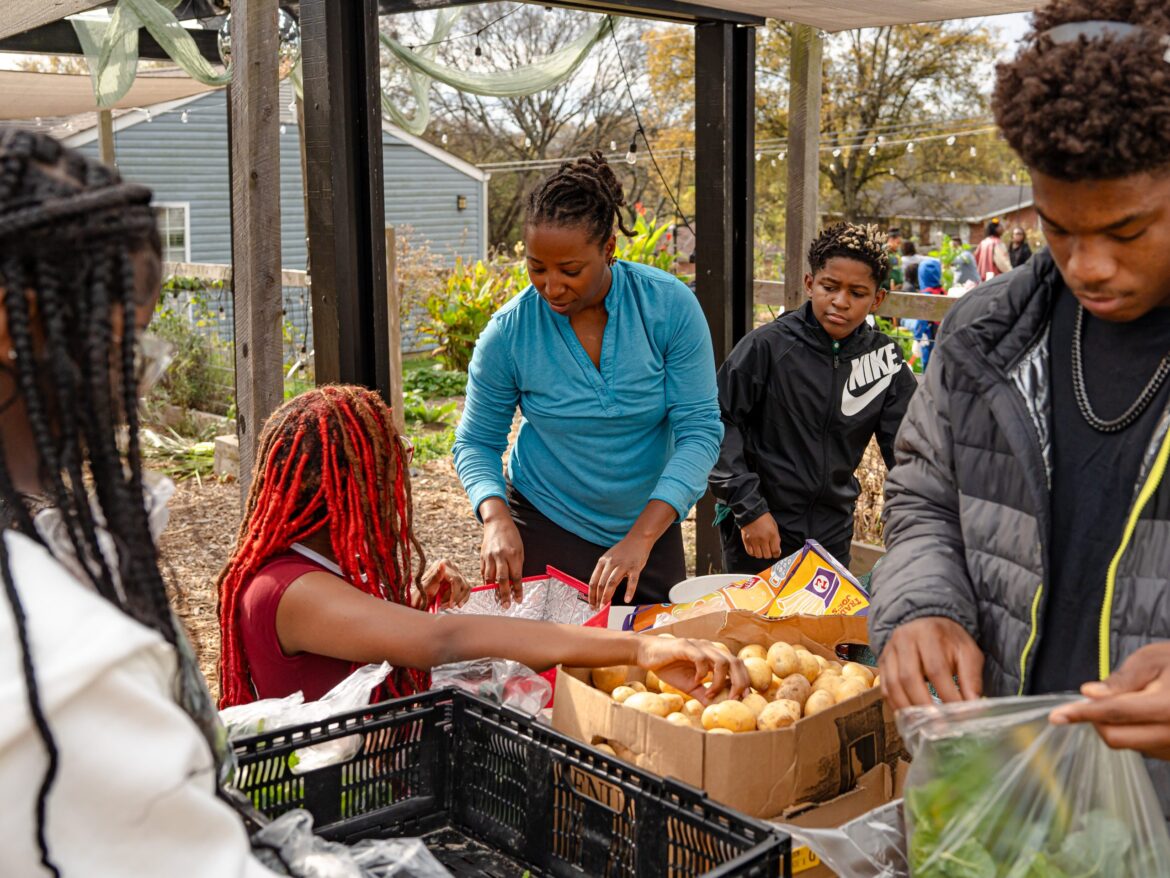🦅 The best of the Banner in your inbox with The Flyer newsletter.
In 2020, Amber Fayne was told that she couldn’t work anymore. There was something wrong with her kidneys. She had some money saved up, and moved around with her husband and young son. Over the next few years, Fayne had two heart attacks and she and her family became displaced. Her health began to decline, and eventually she needed to have both her legs amputated. In 2023, she and her family moved from Memphis to Nashville and found stable housing.
But the food, Fayne said, had always been a struggle.
As a diabetic and a patient with heart challenges, Fayne has to adhere to a strict diet, consisting of vegetables, herbs and spices, which can quickly become costly. Even using the wrong spice in her recipe could throw off the electrolytes in Fayne’s kidneys, requiring a trip to the hospital.
Fayne also has to feed her family, and only gets paid $1,300 each month for her disability. Her husband stays at home helping raise their son, now eight years old.

Families like hers have been adversely affected by the pause in SNAP benefits caused by the federal government shutdown. Around 700,000 recipients in Tennessee — 121,000 in Middle Tennessee and 60,000 in Davidson County — have been left without the extra dollars that allowed them to pay for groceries.
“I know it’s not just about us,” Fayne said, pointing to the millions of others across the country who are struggling right now. “It’s only so much you can feed with a certain amount of money, especially when you have a household of people, financial responsibilities such as rent [and] utilities — vital necessities that you need to have a decent quality of life.”
Katerina Brewer knows this all too well. As a disabled stay-at-home mother, Brewer relies on food stamps to feed her family. Her fiancé is out of work due to a neck injury. But now that SNAP has been paused until further notice, Brewer said she and her family don’t know what to do next.
“SNAP getting taken away has been this big detriment on … how we feel as a family not being able to provide for our son,” she said.
Brewer’s son loves to eat meat and fresh vegetables, and cuts his food alongside Brewer in the kitchen when she’s preparing meals in the morning. With the loss of their SNAP funds, Brewer and her family have been primarily eating with the help of a food pantry.
“I feel like he’s not eating as much because it’s not tasting the same as what he’s used to,” she said. “I know that people have their thoughts about SNAP recipients buying all their junk food, but we’ve always used it really well for healthier things.”
She continued: “It’s hard being at a point now where we can’t even give our son healthy food and everything’s just kind of in a can or whatever discount we can get from the store.”
 Demitrius Knowles, 17, of Imani Montessori School picks tomatoes from the Brooklyn Heights Community Garden. Credit: Martin B. Cherry / Nashville Banner
Demitrius Knowles, 17, of Imani Montessori School picks tomatoes from the Brooklyn Heights Community Garden. Credit: Martin B. Cherry / Nashville Banner
The government shutdown has also impacted the nonprofit organizations that aid SNAP recipients. Brant Harrell, Tennessee Justice Center’s legal director, told the Banner that nonprofits are still reeling from a lack of funding caused by federal grant cuts earlier this year, and are scrambling to help those in need.
“There’s still a sustained crisis with nonprofits,” he said. “In part of that is because of the funding itself for November, but it also was at a time when there were program changes to the SNAP program that were ramping up.”
Harrell called the combination of challenges the “perfect storm.” Due to the funding cuts, most nonprofits had to make changes to their operating costs. Then came an influx of more families and individuals. The needs are insurmountable.
Under the SNAP program, the government dispersed about $145 million per month to roughly 700,000 eligible recipients across Tennessee. That scale is important: For one meal that a nonprofit can provide a family, Harrell said the SNAP program provided nine.
“SNAP is just indispensable as a program,” he said. “With the absence of benefits coming online, it’s incumbent on food banks and faith-based groups and others to try to fill that gap. It’s a huge gap to fill.”
Bridging the gap
When Lacey Montgomery saw a need in her community, she jumped at the opportunity to help in some way. She was living in Sevierville when Hurricane Helene hit. She traveled out to the towns that were severely impacted, volunteered and stayed for six-and-a-half months. Her experience led her to change careers.
After living in Florida for a few months, she and her family moved to Nashville earlier this summer. She founded her community-based organization, Music City Mouths to Feed. When she learned that SNAP benefits would not be renewed for November, she and her friend put together a Google Form, encouraging families in need to sign up and get matched with a sponsor.
In just seven days, more than 60 families reached out for assistance.
 Garden beds in front of a newly installed tunnel greenhouse at Brooklyn Heights Community Garden. Credit: Martin B. Cherry / Nashville Banner
Garden beds in front of a newly installed tunnel greenhouse at Brooklyn Heights Community Garden. Credit: Martin B. Cherry / Nashville Banner
Both Fayne and Brewer heard about Montgomery’s assistance program on Facebook. Fayne has been matched with a sponsor who helped provide groceries for her family, and Brewer’s donated warm winter clothing for her son.
Fifty-eight families in total are still waiting for a sponsor, and 15 sponsors have signed up to help those in need. Montgomery and her team have been working around the clock to match families and make a difference.
“There’s a lot of people that want to help, but they don’t know how,” Montgomery said, “and then there’s a lot of people who are embarrassed to ask for help or don’t even know where to go to ask for help.”
Kate Wiggins, a volunteer who helps Montgomery with data entry and networking — and is a sponsor herself — told the Banner that she’s happy to help her community.
“It’s [about] being in solidarity with people who are in need right now and whose needs are not being met at all by the government,” Wiggins said. “To me, it just feels like a human responsibility.
“Right now, I’m helping, but down the road, I could be the person in need.”
Creating a crisis-proof future
Every Friday morning, Brooklyn Heights Community Garden (BHCG) hosts two dozen young people between the ages of 8 and 17 for an immersive program called Food for Justice. The participants, who are either homeschooled or enrolled in Imani Montessori School, do a variety of agriculture and community service related work.
The garden’s founder, 69-year-old Nella Pearl, believes that this program is a viable solution to fighting food insecurity now and in the future.
“I started BHCG to address a need for balance in the community.” she said. “I knew that in order to heal, we had to learn to take care of one another, starting with food.”
Equitable access to food, along with transportation, has been a decades-long concern for Pearl. The current youth programming model was created from her initial desire to feed her own five children and provide support for other families struggling with food insecurity.
“I have five biological children and have cared for nearly 55 other children [nieces, nephews, and other children in the community] in the past two decades,” Pearl said, reflecting on how the garden’s youth programming has evolved. “I’ve always wanted to empower young people and let them know that they absolutely have the power to care for themselves and their neighbors.”
The morning jobs students share weekly include: spreading mulch; harvesting produce like tomatoes and turnip greens; packaging and delivering CSA shares to neighbors; and preparing the soil for growth during the winter.
“My favorite part is giving produce bags to neighbors,” said 12-year-old Ava-Skye Vaughn. “Knowing that people can get fresh fruits and vegetables for free is inspiring because no matter the circumstance, everyone deserves to eat.”
Through the program, students also have the opportunity to learn from local businesses, attend farm-forward field trips, and learn from other organizations and grassroots initiatives that advocate for food justice.
“This year, I learned about food deserts and how a lot of individuals and families in Nashville’s neighborhoods are not able to access fresh food,” Gabriella Simms, a 14-year-old freshman at Imani Montessori School, said. “I used to think young people didn’t have a role to play in food justice, but after this program, I understand why it’s important for people of any age to know what you’re eating, consuming and how you can get it.”
Ashley Brailsford, lead program and development support said, “As opposed to being a rapid-response operation, we’re essentially creating a new system that is crisis-proof. Our food shares don’t come from lack, but rather an abundance of community care through fresh produce.”
With their mission of getting young people involved in creating solutions to food insecurity, Brailsford and Pearl both acknowledge the challenges that affect the program’s delivery.
“In order to continue our efforts, it requires additional investment from the city of Nashville, local businesses, and corporations who understand that they have a responsibility to the people to take care of one another,” Brailsford said.
“Our youth programming could be a model to others, but with a skeleton crew of just four incredible Black women and dwindling resources, it’s difficult trying to feed everyone,” Pearl added. “When we started it was 200 homes. Now, there are about 600 individuals to feed.” She said the group needs funding for refrigeration, and to hire tradesmen and women like carpenters, electricians, plumbers and irrigation specialists, as well as strategic positions. The vision also goes well beyond food.
“One of our goals is to also house the people who volunteer and have a dedicated space for interns,” she added. “We have people on our own team who are struggling with transportation, food and housing insecurity.”
 Ms. Nella Pearl, founder of Brooklyn Heights Community Garden. Credit: Martin B. Cherry / Nashville Banner
Ms. Nella Pearl, founder of Brooklyn Heights Community Garden. Credit: Martin B. Cherry / Nashville Banner
Studies show that children who learn how to garden are much more likely to continue gardening later in life. This could be lifesaving for scenarios like we’re facing now with so many individuals and families uncertain about where they’re going to get their next meal.
“We are planting seeds now and harvesting leaders … prepping them to understand that when and if there is a crisis, they’ll have the tools to maneuver through it,” Brailsford said.
Jimmi Mac agreed. Now the garden’s youth mentor, she began volunteering in 2019. She feels as committed as ever.
“We heal here. We build here. We cry here,” she said. “It’s a safe space for the youth. Right now, they’re in the back signing and being their most authentic selves. It’s so beautiful teaching these youngsters about the land and how we are reclaiming it.”
While they don’t have hard statistics to show yet, the staff and participants of the BHCG Food for Justice youth program are actively creating the change they want to see in the world.
“Connecting with the land and advocating for food justice is a powerful act,” Charmez Burns, 17, a participant and secondary student at Imani Montessori School, told the Banner. He said he is now gardening at home, raising tomatoes, okra, peppers and watermelon.
“This program really puts the future in our hands,” he said. And he takes that seriously.
“If we don’t transfer the information to the next generation, then who will?” he asked. “Learning these skills will help people access food right now. And they will help people access food tomorrow.”
You’ve read 5 or more articles this month. You have unlimited free articles remaining because we don’t have a paywall.
We like the sound of that.
Like sidewalks and streetlights, the Nashville Banner is here to keep our community connected and informed. Now, we’re trying to raise $45,000 for our newsroom by December 15.
At every pivotal moment, the Nashville Banner has been there for our city.
Now, will you be there for us?
You’ve read 3 or more articles this month. You have unlimited free articles remaining because we don’t have a paywall.
We like the sound of that.
Like sidewalks and streetlights, the Nashville Banner is here to keep our community connected and informed. Now, we’re trying to raise $45,000 for our newsroom by December 15.
At every pivotal moment, the Nashville Banner has been there for our city.
Now, will you be there for us?
You read this article for free. You have unlimited free articles remaining because we don’t have a paywall.
We like the sound of that.
Like sidewalks and streetlights, the Nashville Banner is here to keep our community connected and informed. Now, we’re trying to raise $45,000 for our newsroom by December 15.
At every pivotal moment, the Nashville Banner has been there for our city.
Now, will you be there for us?
Related


Dining and Cooking